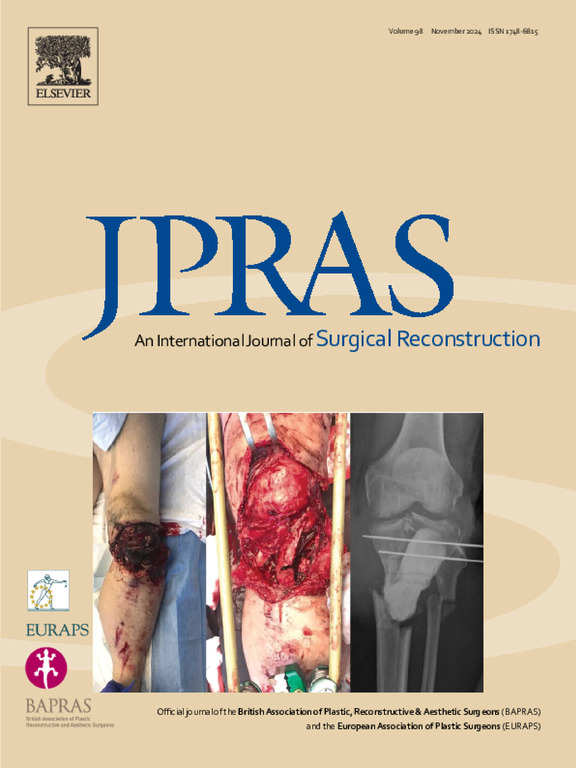Comprehensive treatment approach for hemifacial microsomia: Integrating orthognathic surgery with sequential customized implantation
IF 2
3区 医学
Q2 SURGERY
Journal of Plastic Reconstructive and Aesthetic Surgery
Pub Date : 2024-09-07
DOI:10.1016/j.bjps.2024.09.015
引用次数: 0
Abstract
Objective
This study aimed to evaluate the clinical outcomes of combining orthognathic surgery with staged patient-specific implants (PSIs) for comprehensive craniofacial asymmetry reconstruction in adult patients with hemifacial microsomia (HFM).
Methods
Six adults with HFM (1 Type I and 5 Type IIa) underwent orthognathic surgery to correct skeletal malocclusion and chin deviation. Sequential PSIs were implanted to address craniofacial asymmetry. Digital lateral cephalograms and cranial computed tomography scans were obtained at four time points: pre-orthognathic surgery (T0), within three months after orthognathic surgery (T1), one year after orthognathic surgery and just before personalized implantation (T2), and after personalized implantation (T3). Evaluation parameters included skeletal and dentoalveolar measures, occlusal cant, chin deviation, skeletal stability, and facial contour symmetry.
Results
At T1, no significant differences were observed in skeletal movements compared with planned surgical movements (p > 0.05). Similarly, at T2, skeletal movements did not significantly differ from those observed at T1 (p > 0.05), indicating surgical precision and stability. Analysis of skeletal and dentoalveolar parameters, occlusal cant, and chin deviation revealed significant increases in SNB, FH-NPo, and ST N vert-Pog at T1 compared to T0 (p < 0.05), along with notable improvements in chin deviation and occlusal cant (p < 0.05). Comparison of T2 to T1 showed no significant changes in SNB, FH-NPo, ST N vert-Pog, chin deviation, or occlusal cant (p > 0.05), indicating substantial postoperative stability. After personalized implantation (T3), further significant improvements were observed in skeletal symmetry.
Conclusion
Combining orthognathic surgery with staged PSIs effectively reconstructs craniofacial asymmetry in adult patients with HFM, achieving significant improvements in skeletal alignment, occlusal cant, and chin deviation, with stable outcomes over time.
半颌畸形的综合治疗方法:正颌外科手术与按顺序定制的植入手术相结合。
研究目的本研究旨在评估将正颌手术与分期患者特异性植入体(PSI)相结合,对半颜面小畸形(HFM)成人患者的颅面部不对称进行全面重建的临床效果:六名成人半面小畸形患者(1 名 I 型,5 名 IIa 型)接受了正颌手术,以矫正骨骼错位和下巴偏斜。为解决颅面部不对称问题,患者接受了序列 PSI 植入术。在正颌手术前(T0)、正颌手术后三个月内(T1)、正颌手术后一年及个性化植入前(T2)和个性化植入后(T3)四个时间点采集了数字头颅侧位图和头颅计算机断层扫描。评估参数包括骨骼和牙槽骨测量、咬合角度、下巴偏差、骨骼稳定性和面部轮廓对称性:结果:在 T1 阶段,骨骼移动与计划的手术移动相比无明显差异(P > 0.05)。同样,在 T2 阶段,骨骼运动与 T1 阶段观察到的骨骼运动没有明显差异(P > 0.05),这表明手术的精确性和稳定性。对骨骼和牙槽骨参数、咬合角度和下巴偏差的分析表明,与T0相比,T1时的SNB、FH-NPo和ST N vert-Pog显著增加(p 0.05),表明术后稳定性很高。在个性化植入后(T3),骨骼对称性进一步得到显著改善:结论:将正颌手术与分期 PSIs 结合使用,可有效重建高频颌面整形术成年患者的颅面不对称,显著改善骨骼对齐、咬合倾斜和下巴偏斜,且术后效果稳定。
本文章由计算机程序翻译,如有差异,请以英文原文为准。
求助全文
约1分钟内获得全文
求助全文
来源期刊
CiteScore
3.10
自引率
11.10%
发文量
578
审稿时长
3.5 months
期刊介绍:
JPRAS An International Journal of Surgical Reconstruction is one of the world''s leading international journals, covering all the reconstructive and aesthetic aspects of plastic surgery.
The journal presents the latest surgical procedures with audit and outcome studies of new and established techniques in plastic surgery including: cleft lip and palate and other heads and neck surgery, hand surgery, lower limb trauma, burns, skin cancer, breast surgery and aesthetic surgery.

 求助内容:
求助内容: 应助结果提醒方式:
应助结果提醒方式:


